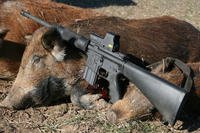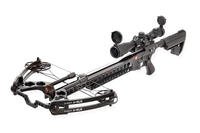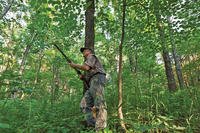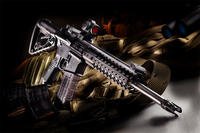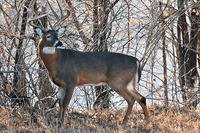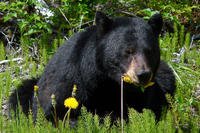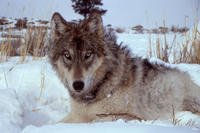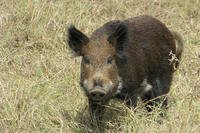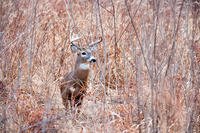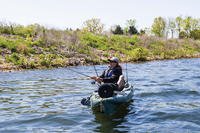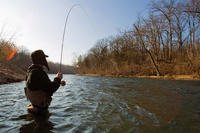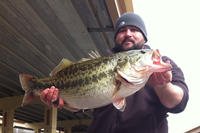Can hunt clubs and individuals create “super bucks” by taking out those that will “never” grow high-scoring antlers?
by David Hart
The rut's on and it seems like you can't sit for 20 minutes without yet another buck prancing past your stand. You've seen a basket-racked 8-pointer, two spikes and one raggedy-horned freak that you vow to shoot the next time he trots within rifle range. One side carries four long tines, but the other is a twisted mess of gnarly bone. Why not take him out, you figure? The little 8-point will be a shooter next season, and the spikes? You'll save those for your kids. You don't want that oddball buck spreading his genetics around your woods and besides, he'll likely never amount to much anyway.
To Cull Or Not…
Hold on a minute. That crazy-horned buck just might be a normal deer next season, says Dr. Charles DeYoung, a research biologist with the Caesar Kleberg Research Center in Kingsville, Texas. A variety of factors can create misshapen antlers, and just because a buck has an odd antler or two this season doesn't mean he will always carry screwy antlers.
"He might have injured his antler in the velvet stage, or he might have suffered an injury to his body," says DeYoung, who specializes in whitetail population dynamics. "In most cases, an antler will be deformed on the opposite side of an injury to the body, but it certainly could be a normal antler in subsequent years."
In either case, there's no guarantee that bucks that appear inferior because of uneven or unusual antlers will remain that way. They might, but the average hunter really has no way of knowing if a deformed antler is the result of poor genetics or just a freak accident. Even DeYoung doesn't always know if a buck should be removed from the herd based on the antlers. He belongs to a large south-Texas lease where a handful of bucks taken by hunters have only a point or two on one side, but as many as five or six on the other antler. On the surface, they seem like clear candidates for culling, and several hunters who participate in the lease do just that. DeYoung, however, doesn't know if those deer should be culled. "I would just as soon let them walk and worry about other things," he says.
DeYoung isn't entirely against the concept of culling bucks. In fact, he's in the middle of a 10-year study that examines the effect of culling on large acreages, a study that will answer a variety of questions about buck management through culling efforts. Mostly, he wants to answer the questions that hunters have been asking for years. Specifically, will removing "inferior" bucks change the genetic makeup of the deer herd and ultimately lead to a population of bucks with bigger antlers and healthier bodies? Although he won't have any answers for several more years, he's not entirely optimistic about the results.
"I'm skeptical we can influence genetics through culling on a free-ranging herd. I would be more optimistic if this was a captive herd in a high-fence situation where we can control dispersal, diet, herd balance and other factors," he says, "but I'm eager to see the results to see if my initial instincts are right or wrong."
The testing methods are unlike anything a typical hunter could undertake, but the results might help hunt clubs and other large land managers do a better job of managing their deer herd for quality bucks. DeYoung and fellow researchers are capturing deer with the aid of a helicopter and net gun. The deer are then aged and their antlers measured using Boone-and-Crockett-Club methods. On one area, bucks that fall into the "cull" category - yearlings with less than six points; 2-, 3- and 4-year-olds with less than eight points; and older bucks that score less than 145 B&C points - are killed and the meat donated to local food banks. Those that are above the cull standards are recorded and released. On another area, all bucks older than 2 years are removed from the population; the remaining deer will be analyzed throughout the length of the study. A third area will remain untreated as the control area.
How Old Is That Buck?
The problem for most hunters who want to use culling methods to create a high-quality hunting opportunity comes down not just to the ability to come in contact with so many bucks. It also boils down to correctly aging those bucks they do come into contact with. Even more problematic, hunters have to age those bucks before they pull the trigger, otherwise they cull by antler size and not age. Culling should be done based not on one of those criteria, but both.
DeYoung comes in direct contact with as many as 1,500 bucks per year. Many of them are the same bucks he's touched previously, but as the seasons change, so does the condition and physical appearance of those deer. He not only examines them from a distance, but he usually has the opportunity to age them by examining their teeth while the deer are under sedation. He also takes other data, including weight, antler characteristics and often B&C scores. Most hunters are lucky to see a handful of whitetail bucks in a typical season, so it's virtually impossible to estimate a deer's age as it walks through the woods a hundred yards away. Even hardcore whitetail fanatics can't often age a buck correctly.
"It's fairly easy to tell if a buck is a yearling, but once they get up in the 2- to 3-year-old range, it gets more difficult to accurately estimate their age," DeYoung says. "I can think of several bucks I estimated to be 2 or 3 only to find out they were 6 when I examined their teeth." That's why it's virtually impossible to judge a deer's age or potential simply by examining antler points, shape or mass and then deciding if it's a cull buck. Even if that buck is a pencil-horned spike.
The Spike Theory
The myth that a spike will always be a spike has been put to rest long ago, but there are still hunters who believe that bucks that wear spikes as their first set of antlers are inferior and will never grow a big rack. Thus, they willingly shoot every spike they see in an effort to "improve" the bucks that remain. In some ways, taking spikes out of the herd can help the remaining bucks grow bigger, says DeYoung, and researchers have determined that yearlings with four or more points do tend to grow larger antlers later in life than those bucks that only carry spikes as yearlings. In fact, a study conducted between 1998 and 2007 followed bucks as they aged and found that only a small fraction of yearlings that carried spikes - 3 percent - grew antlers that scored higher than 150 B&C points after they reached 5 ½ years or older. On the other hand, 33 percent of yearlings that had at least four points scored 150 or higher. Further, only 8 percent of bucks that had eight or fewer points at 3 ½ years of age grew antlers larger than 150 B&C later in life, while 37 percent of 3 ½-year-old bucks with nine or more points ended up growing antlers over 150. But again, all of that data is moot if you don't know the age of the bucks you are looking at. So do you shoot that small 8-pointer standing in front of you? Depends.
"Taking out some bucks that meet any standard you place on them automatically leaves more food for those bucks that remain. However, you will achieve the same general results by removing antlerless deer," explains DeYoung. "Some studies have shown that bucks have somewhat different dietary requirements and intake than does, but it's probably not that big of a difference to have any management implications for most hunters." Small antlers on a yearling buck might be the result of something as benign as a poor mast crop the previous fall. DeYoung says the health of a fawn is usually determined not only by the forage directly available to that young buck, but also by the forage available to its mother. When fawns are still nursing, their body mass is determined by the health of their mother. An underfed fawn this season might ultimately grow healthier in subsequent years and carry bigger antlers.
A high number of spike-antlered bucks could also be the result of what DeYoung calls stunting, which happens when too many deer occupy too little habitat. It's similar to a pond filled with bluegills. When there isn't enough food to adequately feed all the fish, they continue to breed but they simply stop growing because they aren't getting proper nutrition. It's fairly easy to tell if a pond has too many bluegills, but it can take hour upon hour of careful observation and record-keeping to determine if your land is above its carrying capacity for deer. If you do have more whitetails than you should, DeYoung says it's far better to simply knock down the deer herd to a level at which there is more food available to fewer animals by shooting more does and leaving more bucks, even if they are spikes.
"I don't think it's possible to have too many bucks, except perhaps in extreme cases. Most hunters will likely never face a problem of too many bucks," he says.
No matter how many bucks live on or around your property, those spikes probably weren't actually born on your land. When yearling bucks reach their second autumn (their first year with visible antlers) they are forced out of their home range by their mothers and often travel miles before establishing new home ranges, a natural phenomenon biologists call dispersal. The spikes you see on your land during rifle season were likely born miles away and might be the product of a giant buck. Those bucks born on your farm are likely at the other end of the county when hunting season starts. That makes any management effort through culling difficult at best.
The bottom line? Unless your deer herd is enclosed in a high fence and you have a degree in biology and hour upon hour of free time, it's unlikely you'll be able to determine the "right" bucks to cull from the herd. Instead of focusing on which ones to take out, spend more time passing up bucks that don't meet your definition of a shooter. Also, shoot more does in order to create a better buck/doe ratio and to create a better forage base for the deer that remain. In other words, let the little ones walk and take only those bucks that are worthy of your table and your wall. That cull buck just might be one of those in a couple of years, if you give him the chance.
